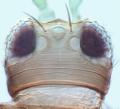Frankliniella parvula
Recognition data
Distinguishing features
Female macropterous; body colour brown; antennal segments brown, III mainly yellow, IV–V brown with extreme bases yellow; femora brown, tibiae brownish yellow; fore wing brown. Antennae 8-segmented, III & IV with forked sensorium, III with characteristic elongate pedicel and small basal ring, VIII slightly longer than VII. Head wider than long; 3 pairs of ocellar setae present, pair III longer than side of ocellar triangle, arising on anterior margins of triangle; postocular setae pair I present but small, pair IV scarcely as long as diameter of hind ocellus. Pronotum with 5 pairs of major setae; anteromarginal setae scarcely shorter than anteroangulars, one pair of minor setae present medially between posteromarginal submedian setae. Metanotum with 2 pairs of setae at anterior margin, campaniform sensilla present. Fore wing with 2 complete rows of veinal setae. Tergites V–VIII with pair of lateral ctenidia, on VIII anterolateral of spiracle; posteromarginal comb on VIII complete, with slender microtrichia arising from triangular bases. Sternites III–VII without discal setae. Male similar to female but smaller, antennae with segments paler; tergite VIII without posteromarginal comb, IX with median pair of setae short; sternites III–VII with transverse pore plate. Second instar larva white, tergite X weakly shaded, tergite IX posterior margin with very small teeth.
Related and similar species
F. parvula is readily recognised by the elongate pedicel on antennal segment III. Although 230 species are currently listed in the genus Frankliniella, most are known only from the neotropics. In the Old World, no member of the genus is native to Africa or Australia, but a few species are European and extend to the Oriental region. Two Frankliniella species are widespread around the world, F. schultzei in the tropics and F. occidentalis in more temperate areas.
Taxonomic data
Current valid name
- Frankliniella parvula Hood
Original name and synonyms
- Frankliniella parvula Hood, 1925: 75
Family placement
Thripidae, Thripinae
Biological data
Life history
Breeding in flowers
Host plants
Associated with the flowers of banana (Musa) and cocoa (Theobroma), but also taken in large numbers in the flowers of some other plants.
Tospoviruses vectored
None
Crop damage
None recorded.
Distribution data
Area of origin
Central America and Caribbean region.
Distribution
Generally distributed in the tropical lowlands between Mexico and Colombia, and the Caribbean islands from Haiti to Trinidad; likely to be intercepted at California in quarantine.





